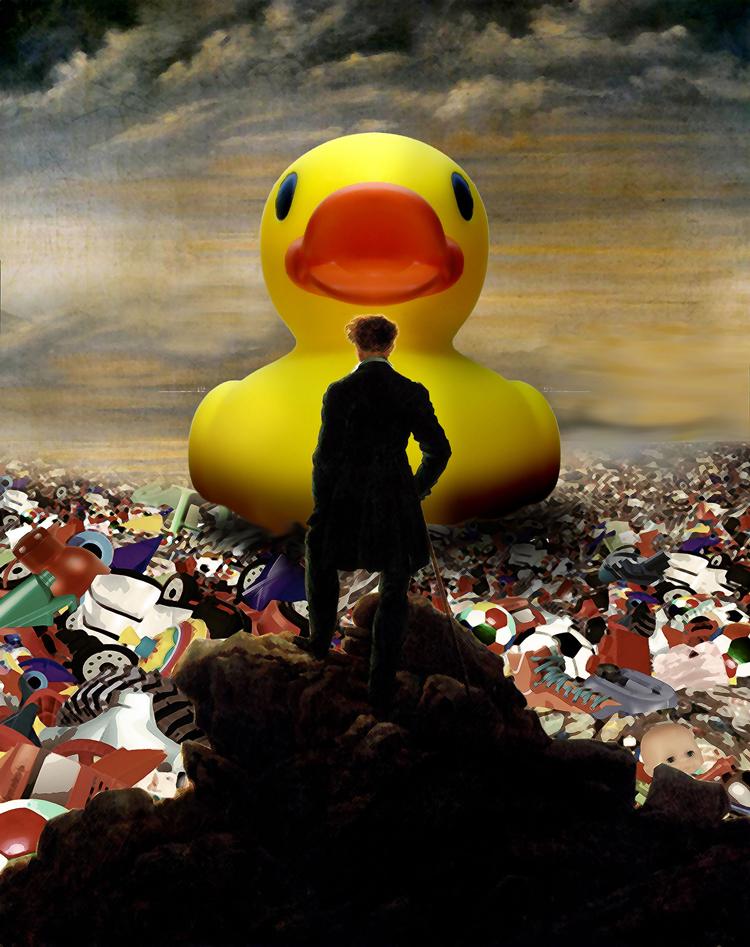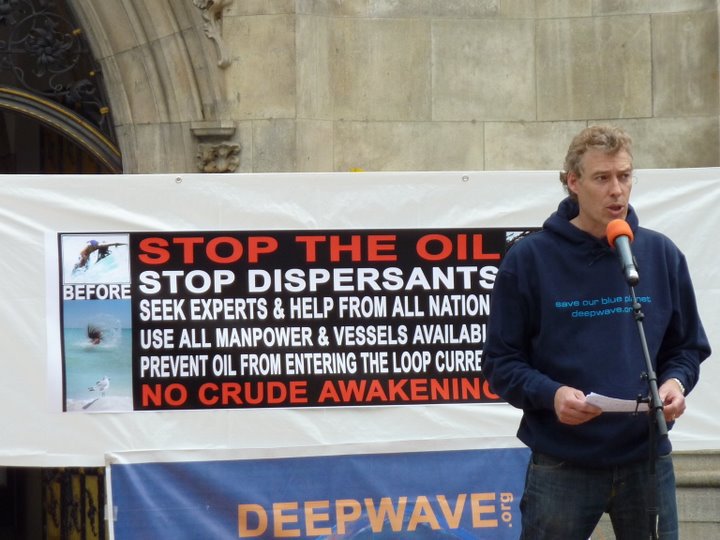Pollution
In cities and urban areas every little drop of rain carries pollutants from factory roofs, parking spaces and streets. The rainwater is contaminated with oil, heavy metals, pesticides, trash, faecal matter and exhaust particles, beginning its journey towards the ocean as road run-off. During flooding events the carried load of contaminants increases even more drastically. In rural areas the rainwater flows across fields, pasture and golf greens, into the receiving waters and drains. Thus, rainwater turns into a toxic cocktail of pesticides, fertilisers and animal faeces. In Chesapeake Bay in the USA, for example, the unfiltered run-off of pig farms frequently leads to spreading of Pfiesteria piscicida: A deadly parasite that leads to mass-mortality of fish stocks and respiratory distress in humans.
Underequipped sewer systems cannot efficiently clear wastewater and run-off during large storm events. Cesspools close to the coast contaminate groundwater and smaller boats often release faecal matter directly in to the ocean.
It is time to identify the culprits through ocean monitoring, to protect the coastlines from toxicants and to legally curb ocean pollution further. The quality of the coast must be maintained in order to avoid the threats posed by harmful algal blooms (HABs) pre-emptively. This can only be done through proper standards, the commitment of every single one of us, and the political drive for effective regulation.
Plastic in the ocean – a deadly threat
It is no longer a secret that our ocean is full of trash. Be this municipal waste or the now-famous ghost nets: The rubbish in the ocean is one of the most pressing threats to the ecosystems’ health. Every year thousands of organisms lose their life to the trash, either through ingestion and thus starvation or by suffocating on the particles. It also poses a threat to entire ecosystems such as coral reefs or sea grass meadows. Plastic bottles enter the high seas and drift towards the Arctic and Antarctic through the currents circulating through the ocean. In 2000 environmental activists found more than 6000 tons of trash across various beaches, in just one day, among which were 13000 single-use syringes. 373 different species had been found entangled among the debris.
One contributing factor to trash entering the ocean is ignorance – many people leave their trash lying around. Rubbish, however, always finds its way into the ocean, resulting in tons of cigarette buds, tampons, single-use syringes and bottles ending up on the beaches and entering the ocean.
Plastic is close to indestructible. 450 years ago we had just about left the Middle Ages behind us and have since written history. However, that is also the same time frame that is required for a PET-bottle or a plastic bag to decompose completely. An insanely long time, especially when considering how much plastic we use these days and that it is often only needed for a short time period.
Sea turtles, for example, often confuse plastic bags with jellyfish and as a result of ingesting too many plastic bags they block their digestive tracts, making for a slow death. Fishnets and –lines, Beer-rings, ropes and other types of trash often entangle fins and other extremities, leading to the drowning or suffocation of the captured organisms. Some of the floating trash accumulations continue causing death for tens of years: entangled species attract predators who in turn get tangled up in the debris.
In order to fight the release of trash into the ocean we need national laws for waste disposal along with the reconditioning and cleaning of local coasts and coastal waters.
This is our factsheet about Plastic in the ocean and the deep se as well as our brochure about plastic.
Sources:
UNEP
Every single one of you can help:
Prevent plastic from entering the ocean by picking up trash when you see it – you may just be saving the life of a marine organism.
Be aware of how much unnecessary plastic you are using and tell companies if you think they are adding plastic where it is not needed (e.g. packaging, wrapping, etc.)
Help the local city and beach cleaners as rubbish collectors, thus preventing the transport of trash into the ocean.

© DEEPWAVE e.V.
Ballast water
Through ballast water of ships millions of exotic animal- and plant species enter foreign bays, deltas and lakes. These invasive species threaten native species by competing for food and habitat, as well as spreading diseases by being vectors for pathogens. Prior to the onset of international ship travels only large wales offered other organisms a chance of being transported across the globe. Nowadays the shipping industry has taken on that task. According to an EU study every second 69 invasive organisms enter coastal waters through ballast water in Germany alone.
Since the 18th Century ships use ballast water in order to place the rudder and propeller deeper in the water and to stabilise the often not fully loaded ships. Depending on the freight that is being transported, these ships will carry as much as 100.000 tonnes of ballast water in their tanks and empty freight rooms. Eight to ten billion tonnes of ballast water are being transported annually, of which approximately 300 million tonnes reach coastal waters and ports. In Germany alone two to ten million tonnes of ballast water is being released annually, containing millions of stowaway organisms. The effect of these exotic species has become more and more clear in the past. Thus, the increased occurrence of toxic algal blooms of algal species from Australia has been traced back to ballast water from Southeast Asia. Aquaculture farms that are in close proximity to heavily frequented shipping routes are suffering under increased parasitic pressures. For example, in November 1998 15.000 million tonnes of farmed Salmon Southern Chile were afflicted and killed due to a Japanese fish parasite, which lead to an economic loss of 90 million US-Dollar. Another example is the European zebramussel Dreissena polymorpha. Since 1985 this species has been spreading across the great lakes of North America where they have been found to block cooling systems of hydroelectric power plants, leading to the need for cleaning these systems regularly (which has lead to very high personnel and economic costs of 4-8 billion US-Dollar in the next ten years). This mussel species originated from the Black and the Caspian Sea, reaching Europe through inland waterways in the beginning of the last century, before entering the USA through international shipping routes. Just as the mussel has found its way to Irish and Argentinian waters, where it is now threatening the drinking water systems as well as the ecology of local waters.
The zebramussel is not the only example for the transcontinental exchange of fauna. Be this the Chinese mitten crab, the American razor clam in the North Sea, the Caribbean seaweed in the Mediterranean, the Japanese planktonic algae in Australia: the list of exotic travellers between the oceans grows with every ship crossing the ocean. Since 1903 159 invasive species have settled in the Northern and Baltic Sea, which means that every seven months a new invasive species permanently settles into the North Sea. 53 new species have been discovered at the English coast, 145 in the Mediterranean, and 172 in Australian waters. Be this microscopically small algae or centimetre long fish: more than 4.000 species have been found in and on ships.
The biodiversity, which is mean to be protected according to the Rio conference Agenda 21, changes drastically due to the transfer of non-native species and in order to reduce future economic and ecologic damages we require quick, multinational actions to be taken. Fitting treatment methods and management strategies for ballast water reduce the risk of carrying non-native species, without leading to high costs. A combination of mechanical and physical or chemical cleaning techniques seems likely for the future. Thus far, the shipping industry only follows the preliminary recommendations of the international maritime organisation IMO. According to them, the uptake of ballast water in rivers and estuaries, close to wastewater treatment plants, during algal blooms and dredging work, and especially at night, when bottom dwelling organisms can be found higher up in the water column, should be avoided. The ballast water should further be exchanged far from the coast, which, however, cannot always be guaranteed due to safety regulations.
Thus, these recommendations are not enough. The majority of these organisms sink to the bottom of the dark ballast tanks, where they stay in a dormant stage until they reach oxygenated waters. This sediment, together with the remaining non-exchanged water, is still incredibly species rich, and these organisms can survive for up to 116 days in the ballast tanks.
It is exactly this ballast sediment, which requires special treatment, since it can otherwise carry toxic algae or pathogens with pose a threat to humans, too. The American Smithsonian Institute in Washington has found streptococci, coliform bacteria and cholera germs in ballast water. 1991 the Cholera-epidemic began along the coast of Mexico and Peru, before occurring in various ports of Latin America, probably spread through ballast water. The cholera germs themselves are not salinity resistant and had been transported in or on other organisms. The elimination of these carriers thus also reduces the risk of transporting these pathogens.
Alongside ballast water there are other modes of transport, such as the shipping of live-fishing bait, the cleaning of aquaria or the overgrowth on ships. We demand stronger regulation for ballast water up take and release, to reduce the risks and to protect the oceans from biological contamination.
Cruise ships
Like floating cities, cruise ships transport millions of people into remote regions of the ocean every year. Mostly unregulated, these ships then unload large amounts of untreated wastewater, toxic chemicals and other rubbish directly into the ocean. These pollutants pose a possible threat to marine organisms, the fragile ecosystems and human health.
The cruise ship industry is booming: 1998 223 ships transported around 10 million people across the globe. Every year this industry grows by about 10 percent, until 2005 a further 50 ships will be added to the fleet-
However, standards for the airborne emissions of these ships are still not stringent enough, the requirements for cleaning wastewater are marginal. NGOs globally are calling from stricter regulations and better recycling for cruise ships. DEEPWAVE supports the “Green Ship” initiative of some European ports, where fees are reduced for safe and ecologically sustainable ships. Devastating examples from the past few years (such as the “Prestige”, to name one), however, show that environmental conservation in the shipping industry still has a lot of gaps, which can only be closed through increased pressure on the IMO.
Text: Onno Groß, 2016

